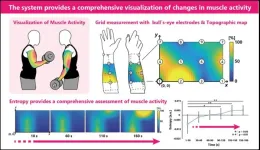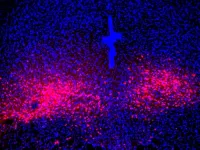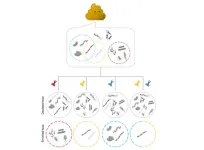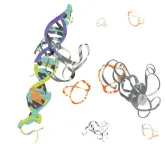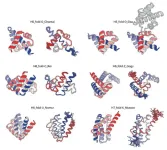(Press-News.org) Surface electromyography (sEMG) is a traditional method used to measure the electrical activity of muscles during physical activity. This method has remained unchanged for over 70 years and involves the use of two standard approaches. The first involves a pair of electrodes—metals that conduct electricity through non-metals—to record from a particular muscle, while the second employs a grid of electrodes arranged in a small rectangular layout in order to measure the potential distribution of intra-muscle activity. However, these approaches only provide a measurement of a single muscle at a time. Thus, limiting our understanding of how our muscles coordinate while carrying out various physical activities.
In a new study published in the Journal of Physiological Anthropology on 27 October 2023, Professor Yoshihiro Shimomura of the Design Research Institute, Chiba University, along with a team of researchers, demonstrated the use of bull’s-eye electrodes to evaluate the activity of multiple muscles at the same time and investigated its ability to assess fatigue and develop visuals of muscle coordination during a grasping task. His team included Ms. Megumi Shimura and Mr. Akihiko Mizumoto from the Graduate School of Science and Engineering, and Dr. Yali Xia from Design Research Institute, Chiba University.
“Ours is the first study to provide images of muscle coordination in the human body and to revolutionize the existing methodology of electromyography,” explains Dr. Shimomura.
The researchers enrolled nine adults without any injuries or health issues for this study. The participants were asked to perform a grasping task. In this task, a pulley system with a handle at one end and a weight at the other end was employed, and the participants were instructed to grasp the handle with the hand most frequently used without moving the forearm. During the task, the bull’s-eye electrode measured the activity of muscles. The performance of this system was assessed using root mean square and entropy—a measure of the disorder of a system.
The findings suggest that an increase in entropy over time indicates an increase in the disorder of forearm muscle due to fatigue. In addition, bull’s-eye electrodes provided an image of muscle activity at nine different points. Thus, the study forms a base for further development of a multichannel sEMG system to increase the scope of measuring muscle activity. “Although our bull’s-eye electrode system has some limitations such as electric gain, it is a robust system that illustrates the muscle activity due to fatigue,” elaborates Dr. Shimomura
Dr. Shimomura concludes, “Having access to an electromyogram can aid in the treatment of muscle disorders of people working in urban lifestyles and improve the health of elderly people. It can also successfully transform the use of one’s body to improve the health and quality of life. Going forward, being able to better understand our electromyogram is likely to change the way we use our bodies and enhance our well-being.”
About Professor Yoshihiro Shimomura
Dr. Yoshihiro Shimomura is a professor at the Design Research Institute, Chiba University, and his research interests include design, ergonomics, and physiological anthropology. He earned his Ph.D. in Engineering from Chiba University in Japan. Dr. Shimomura has published more than 100 research articles and has been felicitated with 25 prestigious awards. He has also been elected to several prominent committees, received grants from more than 100 collaboration works with companies, and maintains 13 patents.
END
An innovative approach for evaluating muscle coordination and fatigue
Researchers from Japan established a novel system to understand how individual muscles coordinate with each other during physical activity
2024-01-04
ELSE PRESS RELEASES FROM THIS DATE:
New theoretical framework unlocks mysteries of synchronization in turbulent dynamics
2024-01-04
Weather forecasting is important for various sectors, including agriculture, military operations, and aviation, as well as for predicting natural disasters like tornados and cyclones. It relies on predicting the movement of air in the atmosphere, which is characterized by turbulent flows resulting in chaotic eddies of air. However, accurately predicting this turbulence has remained significantly challenging owing to the lack of data on small-scale turbulent flows, which leads to the introduction of ...
Scientists use high-tech brain stimulation to make people more hypnotizable
2024-01-04
How deeply someone can be hypnotized — known as hypnotizability — appears to be a stable trait that changes little throughout adulthood, much like personality and IQ. But now, for the first time, Stanford Medicine researchers have demonstrated a way to temporarily heighten hypnotizablity — potentially allowing more people to access the benefits of hypnosis-based therapy.
In the new study, to be published Jan. 4 in Nature Mental Health, the researchers found that less than two minutes of electrical ...
Salk scientists uncover key brain pathway mediating panic disorder symptoms
2024-01-04
LA JOLLA (January 4, 2024)—Overwhelming fear, sweaty palms, shortness of breath, rapid heart rate—these are the symptoms of a panic attack, which people with panic disorder have frequently and unexpectedly. Creating a map of the regions, neurons, and connections in the brain that mediate these panic attacks can provide guidance for developing more effective panic disorder therapeutics.
Now, Salk researchers have begun to construct that map by discovering a brain circuit that mediates panic ...
Gender parity in autism research: Synaptic similarities challenge focus on male models
2024-01-04
New study reveals striking similarities in synaptic abnormalities and behavioral patterns between male and female mouse models of autism spectrum disorder (ASD). The study challenges the traditional focus on male subjects in ASD research and highlights the critical importance of including both sexes in investigations. This finding urges a pivotal shift in the scientific community's approach to understanding and addressing ASD, emphasizing the necessity of considering both males and females to comprehensively ...
Tiredness experienced by Long-COVID patients has a physical cause
2024-01-04
Researchers from Amsterdam UMC and Vrije Universiteit Amsterdam (VU) have discovered that the persistent fatigue in patients with long-COVID has a biological cause, namely mitochondria in muscle cells that produce less energy than in healthy patients. The results of the study were published today in Nature Communications.
"We're seeing clear changes in the muscles in these patients," says Michèle van Vugt, Professor of Internal Medicine at Amsterdam UMC.
25 long-COVID patients and 21 healthy ...
New roles for autophagy genes in cellular waste management and aging
2024-01-04
Autophagy, which declines with age, may hold more mysteries than researchers previously suspected. In the January 4th issue of Nature Aging, it was noted that scientists from the Buck Institute, Sanford Burnham Prebys and Rutgers University have uncovered possible novel functions for various autophagy genes, which may control different forms of disposal including misfolded proteins—and ultimately affect aging.
“While this is very basic research, this work is a reminder that it is critical for us to understand whether we have the whole story about the different genes that have been related to aging or age-related diseases,” said Professor ...
The surprisingly resourceful ways bacteria thrive in the human gut
2024-01-04
The gut microbiome is so useful to human digestion and health that it is often called an extra digestive organ. This vast collection of bacteria and other microorganisms in the intestine helps us break down foods and produce nutrients or other metabolites that impact human health in a myriad of ways. New research from the University of Chicago shows that some groups of these microbial helpers are amazingly resourceful too, with a large repertoire of genes that help them generate energy for themselves and potentially influence human health as well.
The paper, published January 4, 2024, in Nature ...
Genomic ‘tweezer’ ushers in a new era of precision in microbiome research
2024-01-04
In a landmark study recently published in the journal Nature Methods, researchers at the Icahn School of Medicine at Mount Sinai have unveiled mEnrich-seq—an innovative method designed to substantially enhance the specificity and efficiency of research into microbiomes, the complex communities of microorganisms that inhabit the human body.
Unlocking the Microbial World with mEnrich-seq
Microbiomes play a crucial role in human health. An imbalance or a decrease in the variety of microbes in our bodies can lead to an increased risk of several diseases. However, in many microbiome applications, the focus is on studying specific ...
Scientists tame chaotic protein fueling 75% of cancers
2024-01-04
Meet MYC, the shapeless protein responsible for making the majority of human cancer cases worse. UC Riverside researchers have found a way to rein it in, offering hope for a new era of treatments.
In healthy cells, MYC helps guide the process of transcription, in which genetic information is converted from DNA into RNA and, eventually, into proteins. “Normally, MYC’s activity is strictly controlled. In cancer cells, it becomes hyper active, and is not regulated properly,” said UCR associate professor of chemistry Min Xue.
“MYC is less like food for cancer cells and more like a steroid ...
Breakthrough in designing complicated all-α protein structures
2024-01-04
A team of researchers has developed an innovative method to design complicated all-α proteins, characterized by their non-uniformly arranged α-helices as seen in hemoglobin. Employing their novel approach, the team successfully created five unique all-α protein structures, each distinguished by their complicated arrangements of α-helices. This capability holds immense potential in designing functional proteins.
This research has been published in the journal Nature Structural and Molecular Biology on January 4, 2024.
Proteins fold into unique three-dimensional structures based on their amino acid sequences, which then dictate their ...
LAST 30 PRESS RELEASES:
Eye for trouble: Automated counting for chromosome issues under the microscope
The vast majority of US rivers lack any protections from human activities, new research finds
Ultrasound-responsive in situ antigen "nanocatchers" open a new paradigm for personalized tumor immunotherapy
Environmental “superbugs” in our rivers and soils: new one health review warns of growing antimicrobial resistance crisis
Triple threat in greenhouse farming: how heavy metals, microplastics, and antibiotic resistance genes unite to challenge sustainable food production
Earthworms turn manure into a powerful tool against antibiotic resistance
AI turns water into an early warning network for hidden biological pollutants
Hidden hotspots on “green” plastics: biodegradable and conventional plastics shape very different antibiotic resistance risks in river microbiomes
Engineered biochar enzyme system clears toxic phenolic acids and restores pepper seed germination in continuous cropping soils
Retail therapy fail? Online shopping linked to stress, says study
How well-meaning allies can increase stress for marginalized people
Commercially viable biomanufacturing: designer yeast turns sugar into lucrative chemical 3-HP
Control valve discovered in gut’s plumbing system
George Mason University leads phase 2 clinical trial for pill to help maintain weight loss after GLP-1s
Hop to it: research from Shedd Aquarium tracks conch movement to set new conservation guidance
Weight loss drugs and bariatric surgery improve the body’s fat ‘balance:’ study
The Age of Fishes began with mass death
TB harnesses part of immune defense system to cause infection
Important new source of oxidation in the atmosphere found
A tug-of-war explains a decades-old question about how bacteria swim
Strengthened immune defense against cancer
Engineering the development of the pancreas
The Journal of Nuclear Medicine ahead-of-print tip sheet: Jan. 9, 2026
Mount Sinai researchers help create largest immune cell atlas of bone marrow in multiple myeloma patients
Why it is so hard to get started on an unpleasant task: Scientists identify a “motivation brake”
Body composition changes after bariatric surgery or treatment with GLP-1 receptor agonists
Targeted regulation of abortion providers laws and pregnancies conceived through fertility treatment
Press registration is now open for the 2026 ACMG Annual Clinical Genetics Meeting
Understanding sex-based differences and the role of bone morphogenetic protein signaling in Alzheimer’s disease
Breakthrough in thin-film electrolytes pushes solid oxide fuel cells forward
[Press-News.org] An innovative approach for evaluating muscle coordination and fatigueResearchers from Japan established a novel system to understand how individual muscles coordinate with each other during physical activity
